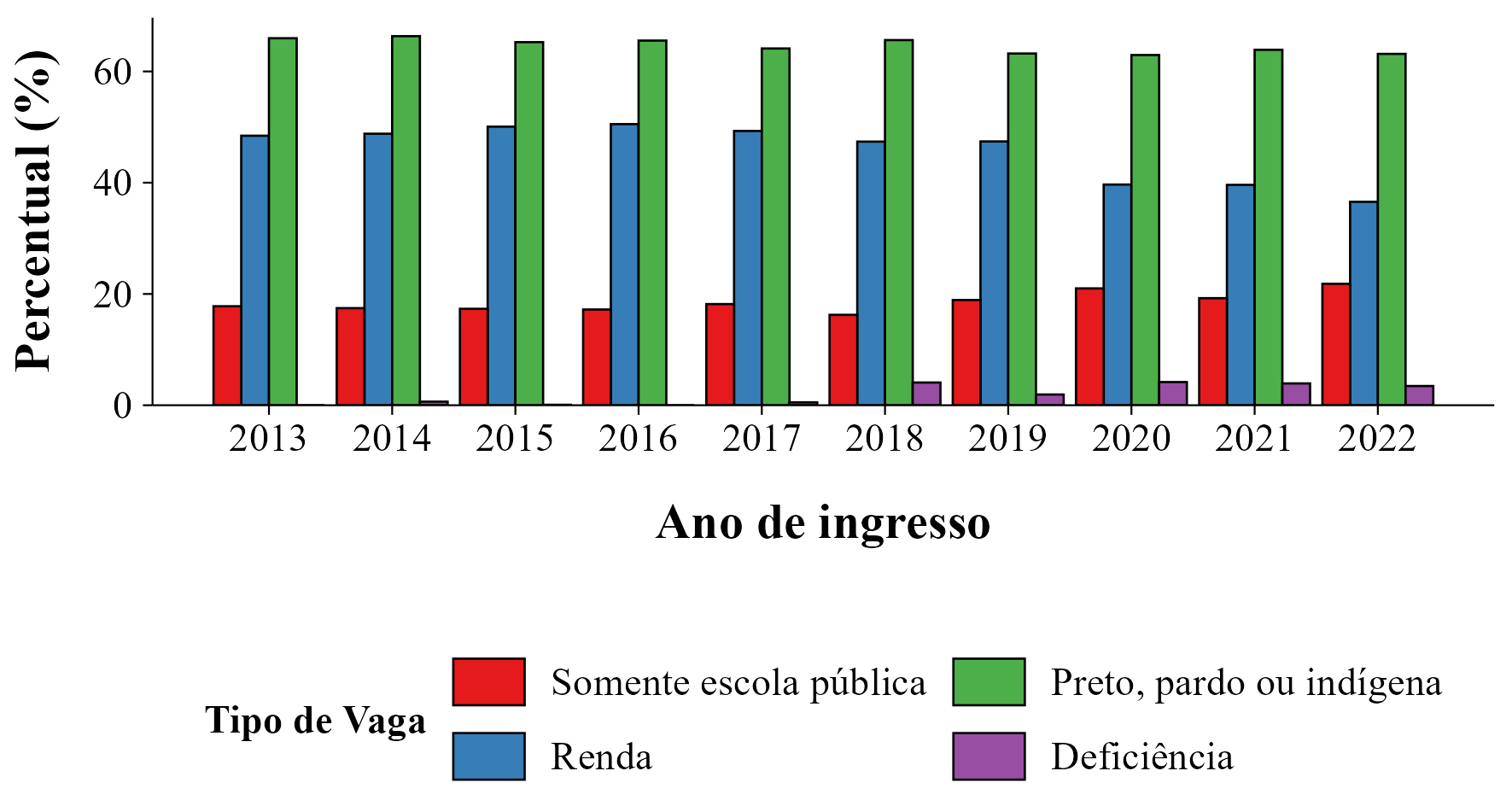Study on the profile of UFMT incoming students after 10 years of the quotas law
Keywords:
Quota students, Higher education, Sociodemographic profile, Affirmative policiesAbstract
Law No. 12,711/2012, known as the Quotas Law, established a significant milestone in Brazilian educational policy by guaranteeing the reservation of 50% of the admissions at federal universities and institutes for students from public schools. Focused on promoting educational equality, the law includes criteria for the inclusion of low-income students, black, brown, indigenous people, and people with disabilities, aiming to mitigate social and racial inequalities in access to higher education. In this context, an analysis was conducted on the profile of students who entered the Federal University of Mato Grosso (UFMT) between 2013 and 2022 through the Quotas Law, aiming to evaluate its impacts after a decade of implementation. Although all quota vacancies are for public school students, only 18.18% were filled exclusively by this criterion, showing the influence of factors such as income and ethnicity. Demographically, 74.89% of quota students identify as black, brown, or indigenous, 53.3% are women, and the average age of entry is 22 years. Only 2.05% reported having a disability, predominantly physical and visual disabilities. Most quota students chose bachelor's degrees (76.28%), especially in Applied Social Sciences and Agrarian Sciences. The research concluded that the Quotas Law significantly democratized access to higher education, including marginalized groups and diversifying the demographic profile of UFMT, although improvements are needed.
References
BRASIL. Presidência da República. Lei No 12.711, de 29 de Agosto de 2012. Dispõe sobre o ingresso nas universidades federais e nas instituições federais de ensino técnico de nível médio e dá outras providências. Brasília, DF, 2012. Disponível em: https://www.planalto.gov.br/ccivil_03/_ato2011-2014/2012/lei/l12711.htm}{https://www.planalto.gov.br/ccivil_03/_ato2011-2014/2012/lei/l12711.htm. Acesso em: 13 mar. 2024.
GUARNIERI, F. V. Cotas universitárias: perspectivas de estudantes em situação de vestibular. 2008. Dissertação (Mestrado em Psicologia) - Universidade de São Paulo, Ribeirão Preto, SP, 2008. DOI: https://doi.org/10.11606/D.59.2008.tde-05112009-202847.
GUARNIERI, F. V.; MELO-SILVA, L. L. Cotas Universitárias no Brasil: Análise de uma década de produção científica. Psicologia Escolar e Educacional, São Paulo, SP, v. 21, n. 2, p. 183–193, 2017. DOI: https://doi.org/10.1590/2175-3539201702121100.
INSTITUTO BRASILEIRO DE GEOGRAFIA E ESTATÍSTICA (IBGE). Pesquisa Nacional por Amostra de Domicílios}. Rio de Janeiro, RJ: IBGE, 2015. Disponível em: https://www.ibge.gov.br/estatisticas/sociais/populacao/19897-sintese-de-indicadores-pnad2.html. Acesso em: 19 abr. 2024.
LOPES, R. A.; SILVA, G. H. G. D. Alcance na admissão de estudantes pela Lei de Cotas: O caso da Universidade Federal de Alfenas. Education Policy Analysis Archives, Arizona, USA, v. 30, 2022. DOI:https://doi.org/10.14507/epaa.30.6370.
LOPES, R. A.; SILVA, G. H. G. D.; FERREIRA, E. B. A Lei de Cotas e o acesso à Universidade Federal de Alfenas por estudantes pertencentes a grupos sub-representados. Revista Brasileira de Estudos Pedagógicos, Brasília, DF, v. 102, n. 260, 2021. DOI: https://doi.org/10.24109/2176-6681.rbep.102.i260.3961
LOPES, R. A.; SILVA, G. H. G.; FERREIRA, E. B. O impacto da Lei de Cotas na Universidade Federal de Alfenas em 2018. Alfenas, MG: Editora Universidade Federal de Alfenas, 2020. Disponível em: https://www.unifal-mg.edu.br/bibliotecas/wp-content/uploads/sites/125/2020/05/17-E-bookimpacto.pdf. Acesso em: 11 set. 2024.
PAGAIME, A.; PRIETO, R. G. Pessoas com deficiência e as cotas do sisu: mapeamento dos critérios de elegibilidade. Cadernos de Pesquisa, São Paulo, SP, v. 54, p. e10610, 2024. DOI: https://doi.org/10.1590/1980531410610
R CORE TEAM. R: A Language and Environment for Statistical Computing. Versão 4.3.2. Vienna, Austria: R Foundation for Statistical Computing, 2023. Disponível em: https://www.R-project.org/. Acesso em: 1 nov. 2023.
SENKEVICS, A. S.; MELLO, U. M. O perfil discente das universidades federais mudou pós-lei de cotas? Cadernos de Pesquisa, São Paulo, SP, v. 49, n. 172, p. 184–208, 2019. DOI:https://doi.org/10.1590/198053145980.
VELLOSO, J.; CARDOSO, C. Um quinquênio de cotas: as chances de ingresso de negros na Universidade de Brasília. Revista Brasileira de Estudos Pedagógicos, Brasília, DF, v. 92, n. 231, 2019. DOI: https://doi.org/10.24109/2176-6681.rbep.92i231.527.
ZUCCARELLI, C.; HONORATO, G. A revisão da Lei de Cotas na educação superior: dados para o debate. Revista Educação e Políticas em Debate, Uberlândia, MG, v. 11, n. 3, p. 999–1017, 2022. DOI: https://doi.org/10.14393/REPOD-v11n3a2022-65070.
ZUIN, A. L. A.; BASTOS, E. A justiça social por meio das cotas na Universidade Federal de Rondônia. Educ. Form., Fortaleza, CE, v. 4, n. 12, p. 104–123, 2019. DOI: https://doi.org/10.25053/redufor.v4i12.945
ZUIN, A. L. A.; CARNEIRO, A. L. P. Lei de cotas e o ingresso de negros no ensino superior: o caso do curso de direito da UNIR. Revista Quaestio Iuris, Rio de Janeiro, RJ, v. 14, n. 03, 2021. DOI: https://doi.org/10.12957/rqi.2021.50989.

Downloads
Published
How to Cite
Issue
Section
License
Proposta de Política para Periódicos de Acesso Livre
Autores que publicam nesta revista concordam com os seguintes termos:
- Autores mantém os direitos autorais e concedem à revista o direito de primeira publicação, com o trabalho simultaneamente licenciado sob a Licença Creative Commons Attribution que permite o compartilhamento do trabalho com reconhecimento da autoria e publicação inicial nesta revista.
- Autores têm autorização para assumir contratos adicionais separadamente, para distribuição não-exclusiva da versão do trabalho publicada nesta revista (ex.: publicar em repositório institucional ou como capítulo de livro), com reconhecimento de autoria e publicação inicial nesta revista.
- Autores têm permissão e são estimulados a publicar e distribuir seu trabalho online (ex.: em repositórios institucionais ou na sua página pessoal) a qualquer ponto antes ou durante o processo editorial, já que isso pode gerar alterações produtivas, bem como aumentar o impacto e a citação do trabalho publicado (Veja O Efeito do Acesso Livre).
